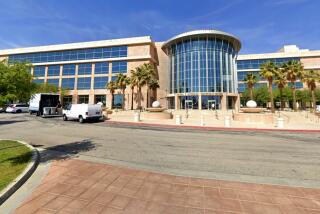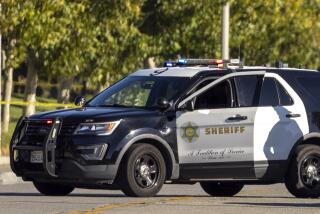No evidence Ruben Salazar was targeted in killing, report says
- Share via
Los Angeles County sheriff’s deputies committed a series of tactical blunders that led to the 1970 slaying of journalist Ruben Salazar, but there is no evidence they intentionally targeted the newsman or had him under surveillance, according to a draft report by a civilian watchdog agency.
The report by the Office of Independent Review, scheduled to be released at a news conference Tuesday, is the first outside examination of thousands of pages of Sheriff’s Department records in a killing that has been clouded by suspicion, controversy and criticism for 40 years. A draft copy of the document was obtained by The Times.
Salazar’s killing became a seminal moment in the Mexican American civil rights movement. And in death, Salazar became an iconic figure, with parks, schools and even a U.S. Postal Service stamp bearing his name.
A columnist and onetime foreign correspondent for The Times, Salazar was also news director of Spanish-language KMEX-TV when he was shot in the head with a tear gas missile. A deputy fired the projectile into a bar where the newsman was taking a break while covering a riot in East Los Angeles.
The 20-page report, which provides previously unreleased details about the case, does not assign blame or wrongdoing, noting that its purpose was to review a historic incident from the perspective of modern-day policing and current department policies and procedures.
The report acknowledged that its conclusions were limited on the key issue in Salazar’s slaying — whether he was a victim of a plot by authorities — because sheriff’s homicide detectives at the time discounted theories that the newsman was killed intentionally. As a result, they failed to ask questions that might have prevented the speculation and conspiracy theories that haunt the case to this day.
The Ruben Salazar Files: Documents from across the career of a newsman under surveillance
“The failure to focus on any aspects of the incident beyond the immediate question of how Mr. Salazar died and the lack of any subsequent internal review by the department, however, left many questions unanswered and opened the door for decades of speculation about what the department may have been trying to hide,” the report says.
The Sheriff’s Department “circled the wagons around its deputies, offered few explanations and no apologies” in the aftermath of Salazar’s death, the report states. “That posture fueled the skeptics.” The department concluded its investigation finding no wrongdoing by its deputies.
The watchdog, however, said that even by the policing standards of the 1970s, the deputy’s use of the tear gas missile seemed “contrary to … [the] department training.”
At the time of his death, Salazar and his KMEX crew were investigating allegations of misconduct by sheriff’s deputies and Los Angeles police. The newsman had told friends that he thought he was being shadowed by authorities and feared they might do something to discredit his reporting.
In the end, the report concluded, the journalist simply may have been in the “wrong place at the wrong time” as buildings burned and deputies clashed with protesters on Whittier Boulevard after rioting exploded during a massive anti- Vietnam War rally.
The independent review was ordered by Sheriff Lee Baca in August after The Times pressed him to unseal the Salazar files. The sheriff has said he will use the report to help him decide whether to release records. He has been urged to do so by members of the Salazar family, county Supervisors Gloria Molina and Mark Ridley-Thomas and others.
The watchdog found that a “hashed up operation in a sea of chaos ... resulted in the tragic death of Mr. Salazar rather than a deftly designed assassination.”
“Certainly through the prism of current best police practices, it cannot be disputed that the deputies who responded to the Silver Dollar Cafe on August 29, 1970, employed poor tactics and made mistakes that resulted in Mr. Salazar’s death,” it says.
The report does cite one intelligence document — found amid the eight boxes of poorly organized reports, memos and other records — that suggests some members of the department were not pleased with Salazar’s reporting. The document, dated simply July 22, is a handwritten note from a sergeant in “Intelligence” who was asking for a copy of Salazar’s press pass because it “appears that (liar) Ruben is spreading bad rumors about us in ELA,” referring to East Los Angeles.
The newsman’s application for his credential was attached to the note, but the report said there was no evidence to suggest that any action resulted from the request. “If Mr. Salazar was under surveillance,” the report says, “either the LASD did not know, or did not maintain any record of its knowledge.”
The report cited evidence that homicide investigators attempted to conduct an unbiased probe. They interviewed a man who said he was inside the bar and heard deputies give warnings for patrons to leave, but who also said he “would be anywhere detectives wanted him to be and say anything they wanted him to say,” according to the report. “To their credit,” the report says, “detectives documented this contact and, obviously, did not use the witness in their investigation.”
The man contacted deputies as a 16-day coroner’s inquest into Salazar’s death was underway. At the time, the proceeding was criticized by Mexican American activists for focusing on the circumstances of the riot rather than the details surrounding the slaying. The inquest concluded that Salazar “died at the hands of another,” which confused observers and angered activists.
The report doesn’t deal with the inquest, but it does lay some of the blame for the lingering suspicions on sheriff’s homicide investigators who failed to ask obvious questions of deputies involved in the shooting, such as whether they knew of Salazar before his death, whether they had been assigned to follow him and whether they were aware that he was inside the Silver Dollar at the time of the shooting.
William Restrepo, a former KMEX reporter who was with Salazar when he died, has told The Times in repeated interviews that deputies were following them as they moved east on Whittier and headed toward the Silver Dollar.
Investigators also failed to resolve another mystery behind the slaying: whether deputies ordered patrons back into the bar before firing tear gas rounds inside.
Deputies told investigators that they had responded to reports of an armed man inside the Silver Dollar and that they ordered people inside to leave. But 12 people inside later told authorities they never heard any such commands. A photograph shot outside the bar moments before the tear gas was fired shows a gun-wielding deputy pointing his weapon at four men gathered outside the door — one with his hands in the air — apparently ordering them into the bar.
“The documents we reviewed,” the report said, “do not resolve this mystery.”
Investigators for the watchdog office spoke with Thomas Wilson, the now-retired deputy who fired the fatal tear gas missile. He said he had no idea who Salazar was or what he looked like — statements that were consistent with what he told detectives 40 years ago, the report states. Wilson said he didn’t find out until hours later that he had killed Salazar.
Moreover, the report added, Wilson said that he was assigned to the sheriff’s station in Montrose and that he volunteered to be deployed to East Los Angeles after the first reports of the rioting began to come in. “This apparent last minute assignment of Deputy Wilson to assist in crowd control does not support the theory ... that he had been specially chosen to target, follow, and kill Mr. Salazar,” the report says.
Still, the report lays out a series of poorly executed tactics and communication breakdowns involving Wilson and other deputies who surrounded the bar after receiving reports that an armed man had entered.
The document said Wilson and the others failed to monitor the back door of the bar, through which any armed suspects might flee. Wilson also said he was in such a hurry to get tear gas inside that he was unaware and didn’t care that he had fired a 10-inch, high-velocity Flite-Rite missile, which was designed for suspects who were barricaded inside structures. He fired two projectiles, the first of which struck Salazar and killed him instantly, according to the report.
Afterward, another deputy arrived as Wilson was behind the building. The two men had not communicated with each other, and the second deputy fired three tear gas rounds at the bar, according to the report.
One of the more troubling aspects that homicide detectives failed to explore, the report said, was how Salazar’s body was left in the bar for several hours.
Deputies said they didn’t go inside because they didn’t have gas masks or a flashlight to explore the dark space.
“Certainly, there was plenty of ‘ball dropping’ with regard to this part of the episode,” the report says. “Unlike with the protocols of today, no one in the department was ever held administratively accountable for the poor response of personnel to concerns that there was someone injured inside the bar.”
Overall, the report says, the outcome of the investigation into Salazar’s slaying would have been different if it had been conducted today. “A wider and deeper investigation into the circumstances surrounding Mr. Salazar’s death undoubtedly would have revealed more facts, better answered lingering questions relating to this incident,” the report said, “and likely would have held persons accountable for poor performance through the disciplinary process.”
Times staff writer Garrett Therolf contributed to this report.
More to Read
Sign up for Essential California
The most important California stories and recommendations in your inbox every morning.
You may occasionally receive promotional content from the Los Angeles Times.











